|
have you noticed a galvanic skin response effect on any of
your instruments when you play them with your hands? if it worked then
meditating or doing deep breathing would effect the sounds methinks.
well, i meditate often with the fourses fyrall and din datin dudero. they all put
out patterns and timbres that keep me interested, that's the key- I'm
not thinking about concrete real world things like money or my house or
my car, etc.., but just this drippy pattern that keeps on depatterning
itself.. it's meditation definitely, but my unassisted meditation is
more like I concentrate on a triangle shape and then have that dissolve
into nothingness nothought. with the kits I can turn off all my
thoughts from the befinning because I'm served this abstract thought
pattern, very useful. Also yes, when I'm playin shows with them, I set
it up however with wires and clip leads, then I just use my hand to
bend out whatever sound I want. it really works, you can shove it and
caress out anything with hand-ear-machine feedback loops. so you can do
a rolling-hand-sound-abstraction-with-nothoughts.
Can we have a forum?
yes, join this yahoo group backwoodselectronics.
for philosophical and light discussion of mystical intuitive dechnical
stuff.
Can you sell your kits without the cases?
I can sell them without a case, I just don't recommend it cuz
I put a lot of work into designing cases that would fit the kits like a
glove, and you would have to reduplicate that work. Also, if you want
to use pegs, you will have to make the case out of some sort of
non-conductive material. One more thing- the price for the kit is based
on the cost of electrical components and the time I spent (more than
four months) designing them. I am making the cases out of wood ripped
from my walls in my house in baltimore, so their money value is
basically free- consider them a handmade gift from me to you. Thus, I
can't discount the kit by leaving out a case.
What is the total current and voltage?
The kits' each can run on any voltage between 3 and 9 volts,
so a decaying 9 volt battery will always do something. They require
about 500ma of current. If you are in a 220V country, look for a
wallwart that outputs 12V at 500ma to 18 volts at 300ma. Make sure it
does DC. (although you could try an AC output adapter, it may work
because the kits have rectification built in). You will know if a
wallwart is too small if the sounds from the ktnk have a 60Hz buzz
riding on top of them. Don't ever give it anything greater than 18
Volts.
How long will it take to make one?
It takes me one solid day of work to finish a kit. I think
that if you are careful and follow the manual,
you should have it done in a week of casual work.
Is there any recommended reading?
You don't need to read anything if you just wanna play weird sounds. If
you wanna get the absolute full experience out of it, and understand
some of the mechanics within, there are two books that will help with
understandin transistors. opamps, current voltage etc. The handwritten
Electronic Experimenter Workbook by Forrest Mims the Third is available
at radio shacks everywhere. The classical tome The Art of Electronics
by Horowitz and Hill should be in the reference shelf at your library.
Also, In the [fyrall's] parasite section P (the one with 3
hairy capacitors) I installed a 1 uf capacitor in the 3rd hairy
capacitor location....I see the schematic advises audio capacitors
(.001 - .1 uf) for this...Should I remove the 1 uf? Will it limit my
fyrall in any way? I want this thing to have the widest range of crazy
noise possible. Have I made a mistake? Or am I ok with that one?
yeah in the parasite section you can put any kind of capacitor. I'm
glad everyone's checking out different sizes, I've found that the
randomest must unplanned values make the wildest range. A 1uf capacitor
there will make it play some nice bass tones, thats all. Remember also
that once you have the ktnk assembled, you can change out capacitors
pretty easily, just clip the leads and solder a new one on to the pads.
I changed a few of the capacitors on my fourses this way- one wiggler
was running too ultrasound for me, so I switched it from .001uf to
.1uf, and it became more bassy. This is a good process, randomly put
'em in, then as you play it switch some out if you want a different
sound.
Can I drill the node pegs myself, please?
You sure can, although it is a lot of work, I understand that some may
want to design their own pattern. Use a 3/32" bit, and note to me that
you want the node pegs undrilled. The reason why I do it is because
first the case is a gift from my workshop and second because random
pegs discourage planned layouts, which discourage intuitive random
guess composition and performance. But I don't want to be a
strucuralist about intuitivists!! If you don't want to be one, that's
fine by me..
Also, I realize that one of the beauties of your design is
that there are no clear inputs/outputs. However, in a general sense are
there fairly clear sets that are "generally" inputs and outputs? Is
there a schematic somewhere on your site for this unit? Thanks!
the ktnk have 6 total nodes that are especially gendered.
These are:
- the "spesal cuck input", which is high impedance, "listens hard" and
modulates the whole instrument based on what it hears.
- the "ar diperso input", which is the preamp for the builtin speaker
- the "crystal transfer stations in the F formation" are the inputs and
outputs of 2 FET preamps (4 total pins), which also output to 1/4"
studio output jacks on the instrument's side. Each station has a pin
for input and a pin for super amplified and inverted output, "ice
stab", which can be sent back into the instrument to create sharp
feedback patterns.
- You can also use the crystal transfer stations in the F formation to
pre-amplify piezo-electric discs, which are, contact mikes. You can
send their signal into the instrument from there.
Would it make sense to connect some potentiometers/diodes
between some of the pegs? i thought maybe this could be fun. as well as
some 555 based astable timers one could attach to somewhere. basically
i'm thinking of such an add-on box sitting next to the main box. this
add-on box could also accomodate some of the variable/switchable hairy
capacitors.
All of these will work. it's all about experimentation. The nodes of
the ktnk are all safe, because they bend like a reed if you get
something stabby near them. A 555 timer is especially stabby, strong
pulls up and down. Since all the sandrodes deal with current directly,
the only thing that can hurt them is over-voltages (something less than
0 volts or greater than 9 volts). The only thing to remember when
adding circuitry is to:
- connect the grounds
- power it with the same positive 9 Volts that the ktnk is getting.
- if you are using something that needs more than 0 and 9 volts, you
can use a 9V zener diode (included in kit) in the connecting cord to
protect the ktnk.
- the ktnks, though, will probably handle over voltages safely enough.
I just have not experimented with this enough, so the ultimate safety
is achieved with thes conditions.
btw - how does one safely discharge a big capacitor without
destroying it? :) and is it safe to connect a big one to your
circuitry? can't it destroy it with too high currents?
big capacitores are scary cuz they are sometimes used to stor
very high voltages, kinda like a battery but that it all comes out in
one big spark if you arc it. Again, since all the sandrodes deal with
current, they can only be hurt by over voltages. Once you have a 1
Farad capacitor in the circuit, it will be safe. It's all about
discharging it ahead of time. A 1 Farad capacitor will make its area
really really really really slow.
There is the U-strip for the feedback-connections. I
thought of using a patchbay here. Do all contacts have to be connected?
Can I leave some open? Can I make double connections?
You can do all of the above. The nodes in this U-strip are safe to be
patched like that. I designed the U-strip so you can make your own
random customization without having to put together a patch bay for the
24 nodes that it controls.
i have a question regarding the kits: there are some green
capacitors of the size of the 102 types. however the labeling says
"2A472K T". can i use them as the 102s?
As for the capacitors, I threw some in-between values in
randomly with the other capacitors. If they are green round edged boxes
(or maybe sea blue or earth red), they are polyester film, they have a
code:
102 = .0010 microfarads
222 = .0022 microfarads
472 = .0047 microfarads
103 = .010 microfarads
153 = .015 microfarads
223 = .022 microfarads
473 = .047 microfarads
104 = .10 microfarads
224 = .22 microfarads
get the pattern? the first two numbers are d'value and the last is a
symbol of the place. These in combination with electrolytic capacitors
(which have their values marked, between 1uF and 4700uF) give you a
really wide range. I think one of the best mods to do to it is to put a
rotary switch there for each hairy capacitor, put the switch on the
side of the box, or use a little switch mounted on the top, to switch
capacitors. the smaller the capacitor the faster the movement at that
wiggelation. imagine flipping a switch and the speed goes from really
slow mountains that last a day to ultrasound beyound hearing range
chaos!!! or even switching two close values .333 to .353 to make just a
slight pitch shift in the normal musical range!! two capacitors in
parallel add values .1+.01=.11.
Also since im really just a beginner, some of my solders
arent too pretty looking, if you know what I mean... Is there any
danger of getting shorts if two solder blobs are real close together,
not touching of course, but close nonetheless? With the hairy
capacitors, obviously I had to bend the leads just so, any short
dangers there, due the wierd way I had to bend them, i mean some lead
is obviously gonna be showing depending on what you use? Also some of
bigger capacitors, especially by the Spesal Cuck on the Fyrall, I had
to put that 104 capacitor in all cockeyed, its touching that diode
right there, and those 102 capacitors, .right next to it. also at its
caddy corner, where you gots that grouping of 3 104 capacitors, they
are snuggly pressed together...
as long as two solder blobs aren't touching, they won't short out. they
can be shaped like mickey mouse and stars but they have to connect in
order to short. bendin leads on capacitors is fine, they still won't
short unless they actually touch something. this is all low voltage
stuff: things can be within 1/100th of an inch of each other and still
not short at all. check out several
projects this stuff can be very messy and still work. i'm glad your
checkin your work though. capacitors squeezing against each other is
fine too, as long as their leads don't cross.
1) I don't think there's going to be room to mount ten
switches (for all ten Hairies), can you suggest which Hairies you'd
pick, or think are most interesting for this mod? 2) Can you give me a
specific recommendation (part # for Mouser or Good ol' Rat Shack) for a
small rotary switch that'd work for this application? 3) Lastly, will I
need to drill out the rotary switch holes like the Pot holes you did,
i.e. with the larger countersunk holes underneath?
i don't have any specific advice on this for you, other than just do
it. you can find all kinds of weird rotary swicthes at radio schack or
try takin apart radios too. even a simple 2 way toggle between two
really different speeds will do a lot musically, and toggle switches
come in many many forms. salvaging is an art, then mounting it in a box
you can do it any way you want, caveman drilled hole with goopy epoxy
and sculpey or precision dentist style. and you can use any kinds of
capacitors you want, the widest range will give you the widest
frequency choices, then the smallest range will give you a more closer
pallet. it's all up to you. oh,
.001 uF is high ultrasound
.01 uF is mid range sound
.1 uF is bass sound
1 uF is wavy slow
10 uF is really wavy slow
100 uF is mountainous slow
|
I've been interacting with the Fourses and I have been
developing a good relationship with it now. Though it does it moody and
hard to tame from time to time. I find the human relationship with the
fourses is very symbiotic and reminds me of a writers relationship with
language. Language is not docile (like the fourses)and creates with the
writer. I guess a typical modular synthesizer would be the opposite
relationship where the modular would be a slave to the
synthesis/writer. Anywhoo on your site i saw that the fourses is in a
"Raga Mode" tuning and the resistor values listed:
.015uF .015uF .1uF 10uF
.01uF .01uF .47uF 10uF
I was curious to how the uF values determined the sound.
Hi There, well, the capacitance really makes the instrument unique, but
in such a non-linear way- it doesn't really directly line up to eight
specifically tuned notes as you have noticed, and that is how the
appelation "raga mode" is misleading, because a mode in the traditional
sense usually applies to a single dimension such as pitch or rhythm.
the thing about the hairy capacitors that I have noticed- if you have
set values, you can always get some representation of high or low
pitches no matter what the values. the entire frequency spectrum is all
there no matter what. I have noticed that similar capacitance values
placed adjacent to each other often react more with each other than
widely different values; this can be ascribed to the idea of difference
tones - textures from similar worlds have more surface for friction,
resonance, bounciness. But throwing a big value in somewhere is a
tradition that I usually keep; the 10uF on the end of each row is a
relatively alien world to the faster .015uF worlds. Of course, in
circuit bending nodes, you totally redirect the energies and the
capacitance takes on less and less of a role in comparison with the
rewovenness. One of the most effective mods you can do to this type of
tuning is switches that add capacitance to the smaller values. For
example, with six extra switches with an extra 10uF capacitor for each
one, you convert this:
.015uF .015uF .1uF 10uF
.01uF .01uF .47uF 10uF
into this:
10.015uF 10.015uF 10.1uF 10uF
10.01uF 10.01uF 10.47uF 10uF
so while you are playing the instrument you instantaneously switch
parts of it into the world of the 10uF value, which should realign it
to react more with the endcap 10uF texture. for an instrument such as
yours I would use the type of switches I use on the VDogs, (mouser part
number 540-rra22h3bbbnn), installed on the front panel. All you need is
a 13/16" drill bit and then gently cut six holes in the side. This will
give you more ultimate control over the instrument, being able to
switch its dimensions instantaneously.
I was wondering how hard it is to, I guess in a sense,
"play".
I'll tell you a few ways I play the ktnks. At home, I like to
cover the instruments with patches with wire worms and metal objects. I
don't think anyone can ever exhaust all the sound possibilities this
way; there are hundreds of connections for each of the hundreds of
sandrodes. On tour, I learned to massage any sound out of the ktnks
with my hands. Since we were playin at live shows, I didn't want to get
as experimental with wire patching as I do at home. I had drawn a few
symbols near my favorite sandrodes of the moment (or rather sandrodes
that I knew a little bit about how they might act), and I could easily
set up a few simple connections to make it go a little bit more crazy
than normal. Sometimes I didn't connect anything at all with wires. I
use hand pressure to tune the chaos and sculpt it to whatever
frequencies timbres or patterns I wanted. It seems right now that
people are playing the fyrall harder, using metal objects to switch
between sounds. And it also seems that people are playing the fourses
more with their hands. I have done both, as well as using the old spoon in the mouth style. Every
gesture you do on this instrument can be an experiment; there are no
wasted moves like you would have on a tr-303 for example, where setting
up a preset patch is a non musical movement. When every gesture can be
musical, I think this is the definition of playability.
On THREE : descion in Mont Alishon (fyrall), there is a
part where its got this analog synth sound and it keeps changing
notes/pitches. How are you doing that?
with my hands, pushing the instrument until it made the bassline that I
wanted.
Can the ktnks output control voltages?
Technically, every sandrode on the surface is active at a multitude of
different frequencies: ultrasonic, sound, phat bass, and "down below
haptic". These "down below" frequencies are the slowly revolving CVs
that you may be looking for. Since the chaos within the kits is
sometimes at a high impedance, it is best to make a preamp for the
signals. There are two preamps builtin along with the speaker preamp,
but these are all optimized for audio frequencies. In the kit manual, I
include a very simple schematic (only one opamp chip in voltage
follower mode) for a CV buffer that would be handy for outputting firm
CVs to your modular.
What is the size of the board?
The circuit board measures 4" x 10", with about 2" extra on one end for
the power regulators and their heatsinks.
What is the size of the case?
The whole thing is 8"x18". It's about 2 1/2" high.
I have no real soldering type experience. Are they hard to
assemble or what? Its not like Im an invalid, Id like to think I could
do it, I have reasonably good hand-eye coordination (17 years of video
game playing) , but Im asking you about your opinion of the difficulty
for a prebeginner DIYer like myself.
As for soldering itself, I feel that anyone can get the hang of it, if
you have the right tools (at least 25 watt iron with fine tip), keep
the tip clean with a wet sponge, and pay attention to detail. I worked
really hard on the manual, and I feel
that it covers every detail in assembly. I think the hardest part about
assembling is just sitting there soldering instead of going
trickertreating! But just relax, get some slow jams going and turn on a
good bright light. I hope that pre-beginner DIYers do this kit, because
I feel that it introduces a bunch of easy and definitely DIYable
techniques.
I would be making a custom panel to accommodate your
creation. Since the front panel is metal, there would be a connection
problem with the pegs. I'm contemplating mini banana jacks or regular
banana jacks. How many pin wires are there on these units?
There are 152 pegs on the fourses surface, and 92 total pegs on the
fyrall, very many. You could maybe experiment and cull the best nodes?
One other idea out of many would be a "metal "picture fram" around a
wooden surface. All the sandrodes could push through the wooden
surface, as pegs. You could use a banana-plug-to-alligator-clip-cord to
send signals from the modular into the sandrode collection. To take
signals from all the sandrodes, you might want a preamp, because the
chaos within the sandrodes is sensitive, high-impedance, and to capture
it you need a high-impedance observation bubble. This is the CV buffer.
You could put pegs around the rim of the wooden surface, as entrances
to CV buffers. The wooden surface is surrounded by a "metal picture"
fram" which holds the CV buffer output banana plugs. Just one idea,
shows only my thought about the ktnk- I am glad that you will find your
own way to do this- send me a pic!
which influence do the connections on the U strip (of the
fyrall) have regarding the feedback patterns (what is a "feedback
pattern" after all?)?
i mean can they substantially change something or are that just minor
changes?
Every ktnk will end up a different beast genetically from the
rest:
- each person will wire up the pegs differently, putting different ones
closer and farther from each other.
- each person will choose different capacitors for all the "hairy
capacitors", places where any value can be used to affect the frequency
characteristics of their area.
- The U strip is one more way to customize your fyrall. I don't know
how much influence the connections have- this whole project is not only
my experiment, but your experiment. I can describe what they are
connecting. The fyrall has three wheels of paradoxical systems. Each is
a cell in a larger wheel, and the U strip sits right before a giant
digital multiplexer in this wheel. A multiplexer is sort of a rewirer,
sending different signals to different places based on its controlling
codes. So the U strip controls how the initial inputs to this
multiplexer are placed.
- I call them feedback patterns because they are just feedback but
woven in a complex and paradoxical braid that always is teetering on
chaos.
i'm thinking of a 24x24 matrix board where i could change
the configuration by patching/inserting some pins. i just don't know if
it would be worth the effort.
sounds interesting and probably worth the effort. I mean everything is
worth the effort. with a matrix board you could even map out the
strategies.
Will there be a place for pictures of customized kits?
of course!
Hey, I got a couple of questions about the fyrall. I read
the manual and listened to the mp3s. Is it possible to feed external
signals (like from a send of a mixer) through the fyrall and process
them somehow, or can external feed "control" the fyrall?
Totally possible. You can do this a few ways. The philosophical article
included with the kit describes how to make a
phono-to-banana-and-alligator cord, which you can send to the spesal
cuck and have the signal crowbar the whole instrument, or you can send
the external signal to any random sandrode and have it rough it up only
locally. In any case, the signal out from a mixer or any other
electronic device is much stronger than those chaotic ones floating
around inside the kits, so it will control them by force. A guitar or
piezo-disc will need a high impedance preamp; the 2 crystal transfer
stations on each kit can do this for you.
hello peter, could i use e.g. such a capacitor? 1F, 20-24V
DC
Sure, u can use any capacitor that's rated at at least 10
Volts DC. A 1 Farad capacitor will make the element that it is part of
as slow as a mountain.
Ok so I started soldering some resistors, actually 3. Its
ok to solder everything from the other side right? Cuz i know you said
that for the chips, in the manual. Should it matter what side as long
as I get a good contact going?? Im tripping out on whether im pushing
enuff in, and if the solder was good. Also what happens if one were to
touch the hot iron to the green plastic part, where there's no
circuitry going on, just blank green? Cuz I might have done a teensy
bit of that. But im sure its bad, right?
yeah all these are totally fine. you can solder from any side as long
as there's some solder truly melted between resistor and pad- there
needs to be a shiny pool somewhere engulfing the resistor lead and pad.
the pool doesn't need to seep through to the opposite side; the holes
are lined already so they conduct from side to side. If you touch the
iron to the green plastic nothin will happen- it's designed to resist
solder and heat, that's what its there for, in case you get any solder
on it it won't stick.
Not shiny solder is bad right? Im thinking the best plan of
attack for the U-strip would be strip the wires, stick em in up to the
insulation & soldering from the underside, that or heat up the pad
stick some solder in then stick the wire in, without getting the
plastic in there, im leaning toward that 1st idea.
as for meltin the insulation, feel free to solder anythin from the
other side, this will totally prevent meltin the plastic, and you can
push the leads in all the way. remember it doesn't have to be perfect
as long as metal parts that aren't sposed to be connected are not
connected. if a solder joint looks dull, and you think it isn't makin
contact, you don't need to unsolder it; just heat it up again and push
some more solder in. if you want to unsolder a wire or a resistor, try
grabbin it with needlenose pliers from the top, then flip the board
over and heat up the joint, until you can gently pull that side of the
component out of its hole. you don't actually need desoldering brain,
cuz if some solder stays in the joint it actually lubricates the joint
in a way- if there is enough solder in there that it all stays
connected then the heat from the solderin iron will be able to conduct
to the whole jiont. this is all the physics of solder that you will
begin to understand by feel. you're right the easiest way to put a new
wire or resistor in a filled hole is to: position the lead with
needlenose pliers right on top of the hole, then heat from the other
side and push it in. then add some new solder from the other side.
Shewed the fourses to a friend yesterday and remebered the
idea of having a display for audience viewing. Basically, just a
breakout box with twins of the eight LEDs but facing the audience. I'm
looking at the schematic...since this is a transistor driven LED, could
I just tap into the board and make a second transistor circuit for each
new LED? That is: 47k resistor, transistor, 470 resistor and LED. 10
wires: pos,neg and 8 signal wires. If you could advise me as to whether
this is good idea or not, I'd appreciate it. Might save me some time if
I'm barking up the wrong tree.
you don't even really need to take from the LEDs, you can just use any
sandrode into that transistor circuit you just described, maybe a
little bit modified-
sandrode - 470k - transistor base - 4.7k - ground
transistor emitter - ground
transistor collector - 470 ohm - LED cathode
LED anode - positive
if you get my drift- the dashes mean connections, so the transistor
base is connected through 470k to a sandrode as well as through 4.7k to
ground. somehin like that. it has high enough impedance to not really
mess up the sandrode, but it also is high gain. try different resistor
values too. yeah it might be nice if you had a few of these, that you
can connect to any sandrode you want to.
|
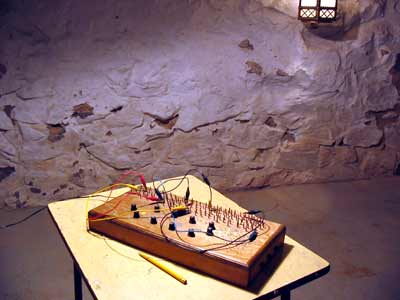
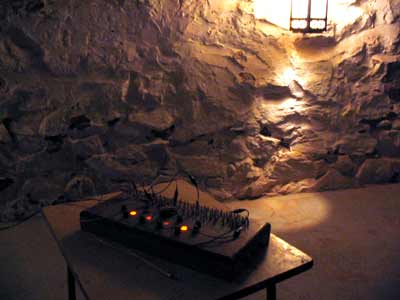
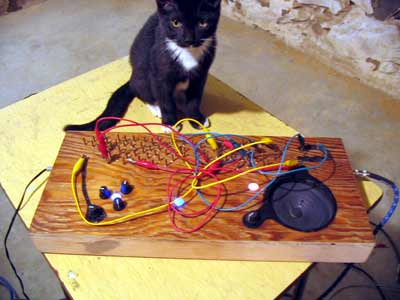 The
Fyrall is available as a kit which you can put together yourself. You
will receive an unfinished case, circuit board, components, wires and
fittings to fully build the instruments. The kit has a builtin speaker
and can run on battery power as well as wall power. Within is a
bubbling spasming analog brain (nabra), with idiomatic digital
circuitry combined to make a logical paradox, a pragmatic little
creature. To interact, twist nobs, look at the lights, touch or wire or
spit on the brass pegs. The brass pegs are sandrodes, connected to
multi-dimensional androgynous nodes within the circuit. Sandrodes are
neither inputs nor outputs, they are both and none; connecting two
together with copper makes a new node with characteristics from both.
The nob dials don't just control one feature, they interact on many
different planes with the beast within.
The
Fyrall is available as a kit which you can put together yourself. You
will receive an unfinished case, circuit board, components, wires and
fittings to fully build the instruments. The kit has a builtin speaker
and can run on battery power as well as wall power. Within is a
bubbling spasming analog brain (nabra), with idiomatic digital
circuitry combined to make a logical paradox, a pragmatic little
creature. To interact, twist nobs, look at the lights, touch or wire or
spit on the brass pegs. The brass pegs are sandrodes, connected to
multi-dimensional androgynous nodes within the circuit. Sandrodes are
neither inputs nor outputs, they are both and none; connecting two
together with copper makes a new node with characteristics from both.
The nob dials don't just control one feature, they interact on many
different planes with the beast within. 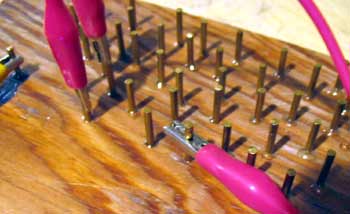 the
Fyrall has a forest of sandrode pegs. You can connect these with wires,
worms, fingers, or any other sort of material. the more you connect,
the more you bend, disrupt, redirect the flows that are natural to the
machine. played by hands the Fyrall becomes a surface for expression,
rolling and pressing and tickling all the pretty farts out. played with
wires, the Fyrall is intuitive composition, listening to what happens
at every move, you find that these hard connections reveal new
dimensions in the pallettt.
the
Fyrall has a forest of sandrode pegs. You can connect these with wires,
worms, fingers, or any other sort of material. the more you connect,
the more you bend, disrupt, redirect the flows that are natural to the
machine. played by hands the Fyrall becomes a surface for expression,
rolling and pressing and tickling all the pretty farts out. played with
wires, the Fyrall is intuitive composition, listening to what happens
at every move, you find that these hard connections reveal new
dimensions in the pallettt.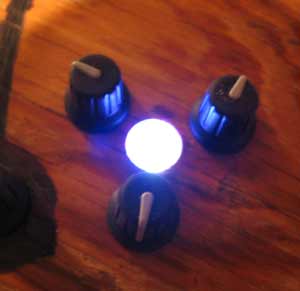 the
Fyralls have nobs and light windows. The nobs are not really "frequency
controls" or "filter cutoff range controls", but more like strange
dialers, with an infinite gradation of zones, twisting becomes
experimentation, feels like a fractal, like traveling through
dimensions, expanding on features invisible.
the
Fyralls have nobs and light windows. The nobs are not really "frequency
controls" or "filter cutoff range controls", but more like strange
dialers, with an infinite gradation of zones, twisting becomes
experimentation, feels like a fractal, like traveling through
dimensions, expanding on features invisible.
